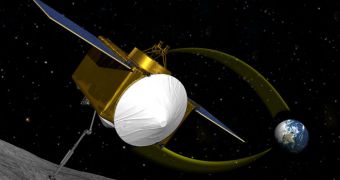As early as 2016, the American space agency will launch a new sample-return mission, which will target a study campaign of the asteroid 1999 RQ36 in 2020. The mission will provide invaluable data on this object, experts at NASA announced on Wednesday, May 25.
The flight will be carried out by an unmanned spacecraft called the Origins-Spectral Interpretation-Resource Identification-Security-Regolith Explorer (OSIRIS-Rex), which will feature advanced scientific instruments to conduct in-situ studies.
Unlike the Japanese sample-return probe Hayabusa, the NASA-developed counterpart will rely on the help of a robotic arm to collect samples, and not just on air filters to collect dust and other particles.
OSIRIS-Rex will then store the samples in special, sealed containers, and take off from the asteroid for a return trip home. The asteroid samples could therefore make their way back to Earth as early as 2023.
The main goal of this research is to aid planetary scientists and geologists gain a better understanding of the way the solar system formed, and also about the timeline this process followed, Space reports.
If successful, the new NASA spacecraft will be the first American probe to carry out such a mission. The Japan Aerospace Exploration Agency (JAXA) Hayabusa spacecraft managed to return several grains from asteroid 25143 Itokawa in June 2010.
What informed the selection of 1999 RQ36 as the target of the new flight is the fact that observations conducted on the object revealed it to be packed with carbon-based materials. This is very unusual, and definitely worth checking out, experts agree.
“We're going for something rich in organics, which might have had something to do with life getting started. That's the idea – time capsule, containing probably the building blocks of life,” scientist Mike Drake told reporters yesterday.
The expert, who holds an appointment at the Arizona State University (ASU), is the principal investigator of the OSIRIS-Rex mission. He went on to reveal that the second reason this asteroid was selected is because it was classified as potentially hazardous.
It will fly very close to Earth in the 2182, calculations have shown. At that time, the chance of impact would reach a level of 1-in-1000, which is really a lot. The asteroid has a diameter of 1,900 feet (579 meters), so experts want to know as much about it as possible.
“We're bringing back something that's essentially untouched by human hands, has not seen the Earth's biota and will be a pristine sample of what's out there,” Drake concluded.

 14 DAY TRIAL //
14 DAY TRIAL //